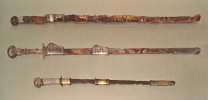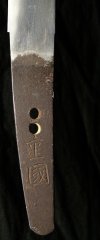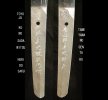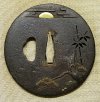I had a gentleman in the store yesterday and he said the sword was of the Nara period (before the samarai). The writing on the sword translated to one five, not 15, but one space five. By the pictures he wasn't able to tell if it was a reproduction. He also said that it would have been owned by a noble family. He was asking if the tsuba was gold or brass, for which I think its just brass.
Well, that is both incorrect and ridicules. If he believes that you should sell it to him.
If it was from the Nara period (710-794) it would be chukoto and most of those are artifacts. Prior to the 10th century all Japanese swords were Chukoto or straight, single edged swords derived from their similar Chinese predecessors. They were nearly all Hira-zukuri or Kiriba-zukuri.
Yours is not straight, not hira-zukuri or kiriba.
Yes, the marks on the nakago are 1 & 5 as on the tsuba. These are not signatures or dates, they are not done that way. These are assembly marks to keep the parts together. These are used on mass assembly items.
With genuine swords, separate artisans make the the tsuba and sword. If they were signed pieces, they would have different signatures.
I will say this one more time, if you doubt my opinion, send it to Shinsa. You will get the most accurate interpretation available.
I hope for your sake I am wrong. However, if you or the other guy would like to make a wager, if submitted to the April 2022 Shinsa and it passes, I will pay for it.
If it fails, you pay me the shinsa fees and publicly announce the results here.
Included are some photo so you can see what the general articles look like.
The first two are Chukoto or Jukoto. 3-4 is what a mei (signature) looks like on a Japanese sword. even a new one. Last, a signed tsuba example.
I hope this is clear now. I know it is not what you want to hear, but your sword is a reproduction.
.










